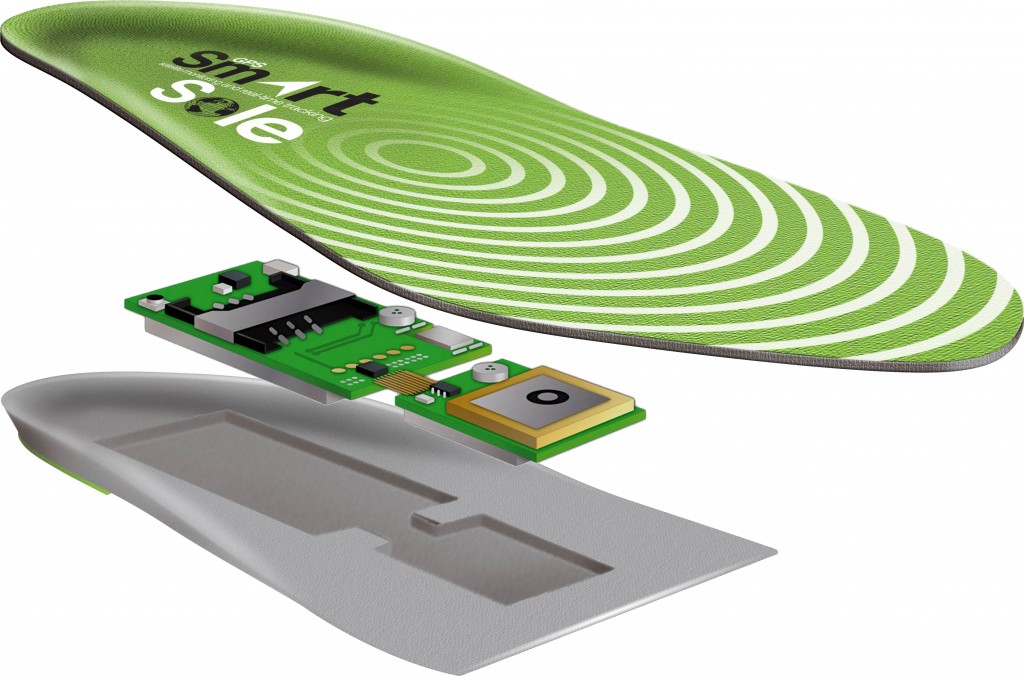
Products  A cross section of the second generation GPS SmartSole shows how the device is housed inside of the insole that goes in the user's shoe.[/caption]
The first generation 'smart shoe' was discontinued in May 2014, followed by a six month hiatus, after which in December of 2014, the second generation GPS SmartSole was launched with a retail price of $299.
A cross section of the second generation GPS SmartSole shows how the device is housed inside of the insole that goes in the user's shoe.[/caption]
The first generation 'smart shoe' was discontinued in May 2014, followed by a six month hiatus, after which in December of 2014, the second generation GPS SmartSole was launched with a retail price of $299.
 An example of how to view the data that the GPS SmartSole sends to the app in order to help monitor the user's whereabouts.[/caption]
Once we learned about this growing number of individuals in the U.S., the product was geared more towards this population. The GPS SmartSole product was intended for the masses, but was then altered to focus on people with memory or cognitive disorders.
An example of how to view the data that the GPS SmartSole sends to the app in order to help monitor the user's whereabouts.[/caption]
Once we learned about this growing number of individuals in the U.S., the product was geared more towards this population. The GPS SmartSole product was intended for the masses, but was then altered to focus on people with memory or cognitive disorders.
GPS SmartSole Gives Peace of Mind to Parents of Wanderers
Over the past four years, we have covered a number of articles about individuals with special needs that have a tendency to wander/elope and the numerous tracking devices on the market that are available prevent disaster from striking. These devices have generally been worn as a watch or attached to clothing. Recently a new and innovative way to track individuals with special needs has been revealed.Meet GPS SmartSole
GPS SmartSole is an invisible wearable technology device intended for non-invasive tracking of individuals with cognitive disorders (such as Alzheimer’s, autism, traumatic brain injuries) in its second generation. The miniaturized GPS/Cellular device is built into an insole designed to be worn in shoes, providing tracking and monitoring for the individual while giving complete peace of mind to the parent who can easily monitor the connected insole right from a mobile app. This technology is a boon for the special needs community, especially the parents and family members that are familiar with the wandering and elopement of those with cognitive impairments. The SmartSole is the invisible wearable technology; the child has no way of knowing that this device is present on their body because it is hidden in the shoe, affording a great advantage to the special needs community.A Few Questions with the CEO
Friendship Circle talked with Patrick Bertagna, CEO of GPS SmartSole’s manufacturer, GTX Corp. (OTC: GTXO), to discuss the latest developments in the technology that bolsters this product.1. Where did the idea/inspiration for GPS SmartSole come from?
PB: The idea originally was conceived from a smart shoe (the first generation of this product) which basically came from the story of Elizabeth Smart in Utah who was abducted at the age of 14 and held captive for nine months. After seeing this story all over the news, the team thought: “What if we had tracking devices in shoes?” The first generation 'smart shoe' device was released in 2012, which was an actual shoe with the electronics built in. Over time, the product design was decreased in size while the second generation was developed to be placed in the sole of the shoe. The new designs also featured increased durability and logistics of the device was much more feasible for the development team to create. [caption id="attachment_21805" align="aligncenter" width="625"] A cross section of the second generation GPS SmartSole shows how the device is housed inside of the insole that goes in the user's shoe.[/caption]
The first generation 'smart shoe' was discontinued in May 2014, followed by a six month hiatus, after which in December of 2014, the second generation GPS SmartSole was launched with a retail price of $299.
A cross section of the second generation GPS SmartSole shows how the device is housed inside of the insole that goes in the user's shoe.[/caption]
The first generation 'smart shoe' was discontinued in May 2014, followed by a six month hiatus, after which in December of 2014, the second generation GPS SmartSole was launched with a retail price of $299.
2. Was anything unexpected learned in the development of this product?
PB: Yes. A tremendous amount was learned about the way people walk, the arch of their foot, their weight, all sorts of different individual factors that had some kind of an effect (either mild or significant) on the outcome of the device. Our first product version had a micro-USB port for charging, but that made it obvious this wasn’t just a pair of Dr. Scholl’s and of course that made them not water resistant. After speaking to experts in the autistic community and getting an understanding of how critical it was for the SmartSoles to be completely invisible and being waterproof, we then converted to inductive charging (see video below), making it a lot easier to charge, sealing the insoles from moisture and now they look like any ordinary orthotic insole. We also learned about the way people walk, the arch of their foot, their weight, all sorts of different individual factors that had some kind of an effect on the user experience.3. What need does the GPS SmartSole serve?
PB: Originally, this product was developed in order to prevent future occurrences, like the Elizabeth Smart abduction in Utah. The inspiration came from the idea of tracking human beings. This evolved into discovering there’s a segment of the population that needs to be tracked because they have a tendency to wander. Nine million people (and growing) in the U.S. currently have some kind of cognitive memory disorder (traumatic brain injuries, alzheimer’s, autism). These people have a tendency to wander and the situation becomes becomes much more complex if they are not found within 24 hours. [caption id="attachment_21806" align="aligncenter" width="720"] An example of how to view the data that the GPS SmartSole sends to the app in order to help monitor the user's whereabouts.[/caption]
Once we learned about this growing number of individuals in the U.S., the product was geared more towards this population. The GPS SmartSole product was intended for the masses, but was then altered to focus on people with memory or cognitive disorders.
An example of how to view the data that the GPS SmartSole sends to the app in order to help monitor the user's whereabouts.[/caption]
Once we learned about this growing number of individuals in the U.S., the product was geared more towards this population. The GPS SmartSole product was intended for the masses, but was then altered to focus on people with memory or cognitive disorders.


